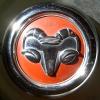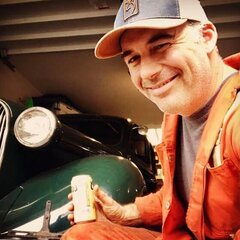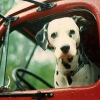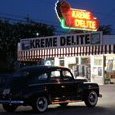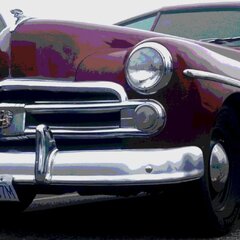All Activity
- Today
-
Bob Ritter started following Rustoleum Appliance Epoxy Enamel
-
I prefer using bedliner paint, comes in black and dries hard. Comes in aerosol cans already mixed just a little masking and your done. Two cans will do the whole floor. I do like Rustoleum engine paint in fact I use it on my small brackets...
-
I ruined a pair of eye glasses from spraying Rustoleum with a spray gun when I was working at the plating shop back in Tulsa. The lenses were plastic, and so I didn't dare try any solvents. I eventually used buffing compound, and finished with toothpaste. I could see again, but they were foggy. I switched back to glass lenses then, and never had plastic lenses again until a few years ago, when they claimed the tri-focals I have to have now would be too heavy in glass. I somehow accidentally got a deep scratch right in the worst spot on the left lens, so had them replaced. Then those lenses delaminated. They didn't accept any responsibility for that, so I went back to glass. Plastic lenses? Never again.
-
That is correct, but the position of the distributor got me confused. Here are a couple of the old factory production images of the 201 engine I made, for reference.
-
I found out about brake fluid the same way - an accident. I had cadmium plated my back plates, and then just spray bombed them with black paint over that. While bleeding the left rear wheel brakes I got some on the backing plate, and the paint ran right off.
-
I am a big proponent of Rustoleum...follow the instructions to the letter, and it is long lasting and durable. My current Rustoleum experiment is a 500 gallon propane tank built in 1964 that I repainted in 2011. It gets morning and afternoon sun and is shaded by a pecan tree that all variety of birds perch on occasion. Once a year, I scrub it with car wash soap...not a spot of rust has reappeared. Remove the loose rust, wash with Dawn between sanding and coating, apply primer and top coats with a foam brush, thin enough that it does not run. Half a gallon of primer did 4 coats, half a gallon of aluminum silver did 4 top coats, no overspray, a few drops spilled, not much cleanup required, and still shiny after a decade of the elements. By contrast, I painted a pair of lawn cart 8" rims right before lockdown. These John Deere rims appeared to have been half-@$$ed painted from the factory back in '02, were rusty within a year, and the cart tires and the 1st replacements were always going flat. So in '20, before I replaced the tires a 2nd time, I peeled the old paint off in chunks, wire brushed off the rust, cleaned per Rustoleum instructions, brushed on primer 2 coats wet sanding between coats, then top coated with rattle can Rustoleum Safety Yellow. These are small rims that I took great care to cover everything in that 1-car garage workshop, and dadgum I found yellow overspray in the oddest places nowhere near where I was working, even with the door closed and no fans on. Anyhow, the rims looked great, and those tires rarely need airing up as that cart hauls rock, dirt, and other heavy loads around.
-
Mine had a white cloth tag sewn into one of the seams, but both were completely deteriorate, with nothing legible at all.
-
In Canada I think Marine marked gas is still ethanol free. That’s what I run in my old cars. Illegal, yes. Lock me up! Hide behind pump so cashier cannot see. Show up with a legal gas can. Cashier will check that you have a gas can. All good. Fill gas can. Stuff fuel nozzle in your car. Proceed to slam all you can in there. Cashier is too distracted with other customers. Pay for your gas and leave. All good! Or go directly to jail. Lol.
-
Did not try that... The "gas test" was only performed because I spilled it while filling-up 😂
-
I speculate that pre ww2 bolts were more likely to be cut but with the advancements in the military equipment, i.e. planes, etc, stronger threaded fasteners were needed. Just a thought. dan...
-
Yeah, I claimed your new couch. So what? Whaddya gonna do about it? Every morning when I come downstairs, his barrel shaped body is stretched out and snoring on MY new couch. It isn't where he starts out at night but it's where he ends up by 6am.
-
Dodgeb4ya started following My Carter B&B carburetor body is porous??
-
Yeah that is the stock correct P23 vacuum advance line. It is suppised to go over the head as shown. It's never been bent out of original shape either. Fuel line looks OE too.
-
Keep your leftover paint and a couple of brushes and touch-up as necessary.
-
Ah ok i got ya. There should be a metal tag wired to the arm rest frame from factory with the part number stamped on it.
-
I have not seen a paint that would hold up to the effect of Dot3 fluid.....powder coat may stand up but would be in my opinion stained at minimum. Most areas you cncerned with are likely not subject to ease of powder coating either. Go DOT5 or forever be ye careful.
-
Unfortunately it looks like my original radiator is near end of life. Getting more pinholes and each time one is fixed, more arrive. So, before it ends up giving up at the wrong time ( Murphys Law) I am looking at getting a 3 core aluminum and painting black. I have a 50 Dodge Coronet with 230/gyro. Does anyone have a good part number I can trust? Just want to make sure before ordering. Thanks much!
-
What about brake fluid? (Just curious.)
-
That's true. However, I've never used POR before. As for the Rustoleum products, specifically mentioned by TS, the best result I had was with their marine paint (applied with a brush). It is UV-resistant (for exterior panels) sands and polishes well, and does not come right off when you spill gas on it 😉
-
automotive paint cost is driven by the collision industry where in by 9 and out by 5 is the shop MO and time is money and the insurance calls the shots on time/material and overall process completely. HOWEVER I would say that 95% or better of hobbyists do not work to that schedule and therefore do not need these products specific to the short availability of the vehicle or shop access. NOR are they working rust issues and or panel repairs of banging out ripples, replacement parts by factory, LKQ or collision panel from a wrecking yard is the time paid for repairs, shops would loose their butts in the first week if repairs were as before. If you paying for those material, well that is your call but they are not needed outside the collision industry.
-
I can absolutely assure you the new paint processes are not cheaper!! The cost of modern, cross-linked auto finishes is staggering, often many hundreds of $$$'s per gallon when you include the necessary reducers and hardeners. Then you add several coats of extremely expensive clear. But the resulting finish is much more durable and flexible (and environmentally friendly) than the old systems such as lacquer and acrylic enamel. To call modern auto finishes "paint" is a misnomer, they should be regarded more as a plastic coating.
-
My response was in regard to the original post about painting floor pans. These are parts of the car that aren't visible once the vehicle is assembled and can accept finishes that you wouldn't apply to the exterior of a hood. One of the common treatments for floor pans is POR which is a relatively thick "paint" that is applied with a brush so the pans will have a durable, rust and chip resistant finish. Rustoleum and similar exterior paints are an inexpensive alternative to the higher-$$$ stuff like POR or multi-stage epoxy and well suited to our old buggies. https://por15.com/products/rust-preventive-coating
-
Black Dog joined the community
-
Looked it up, what I was describing appears to be the good-old lacquer paint application technique. The fact that many technologies are not used anymore, is heavily related to the production efficiency (cheaper) of the process. Not necessarily something one wants to aspire to
-
-
visit a body shop and video the spraying, drying, sanding, respray for each coat.....be a mighty short film what you describing is the primer/surfacers in prep for top coat finish. Only time between coats is the flash time and dependent on temp and solvents used, it never should be allowed to dry between coats, thus a thin coat that will not be so wet to run or sag and when flashed you build your next layer. A good spray job is often described as a controlled run. Spray paint in a can is not for exposed surfaces and in times when you need X color....there is little long term protection with the absence of hardener, you can use these rattle cans but do topcoat clear for the long run. Test compatibility of comingled material on any job. Rustoleum Appliance paint has it uses and I have used it on appliances, for that application, it is ideal. Holds up well to repeated washings.
-
Isn't the proper painting technique, actually, requires thinner paint layer? I was under impression that for general wear parts thin coat is the best (less prone to chipping, etc.) and when you need thicker finish (like on automotive body panels) you apply multiple thin coats, drying and sanding them in between 🤔
-
I've used Rustoleum and Tractor Supply's implement paint for rust "proofing" on many projects over the years. No paint will kill rust that isn't addressed but it can inhibit surface corrosion on clean surfaces. Two VW Beetle floor pans (inside and out) and running gear received the Rustoleum satin and gloss finishes and both have held up well for over twenty years. I usually use a brush because the paint can be applied thicker and the cost and mess is much less than spray cans. I've also bought quarts, thinned with mineral spirits and shot it with a spray gun when that was the best option.

